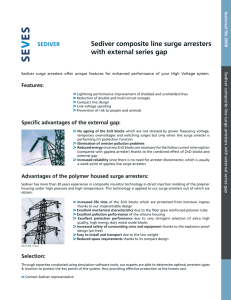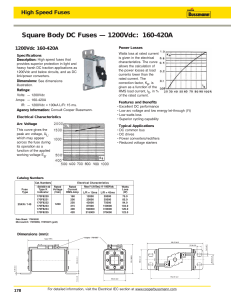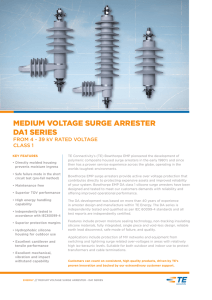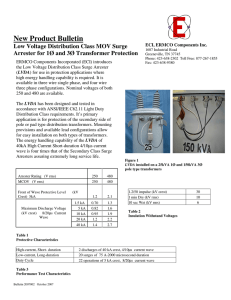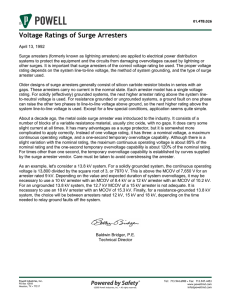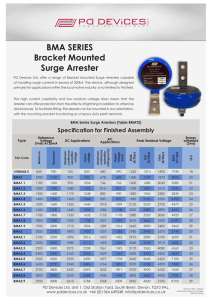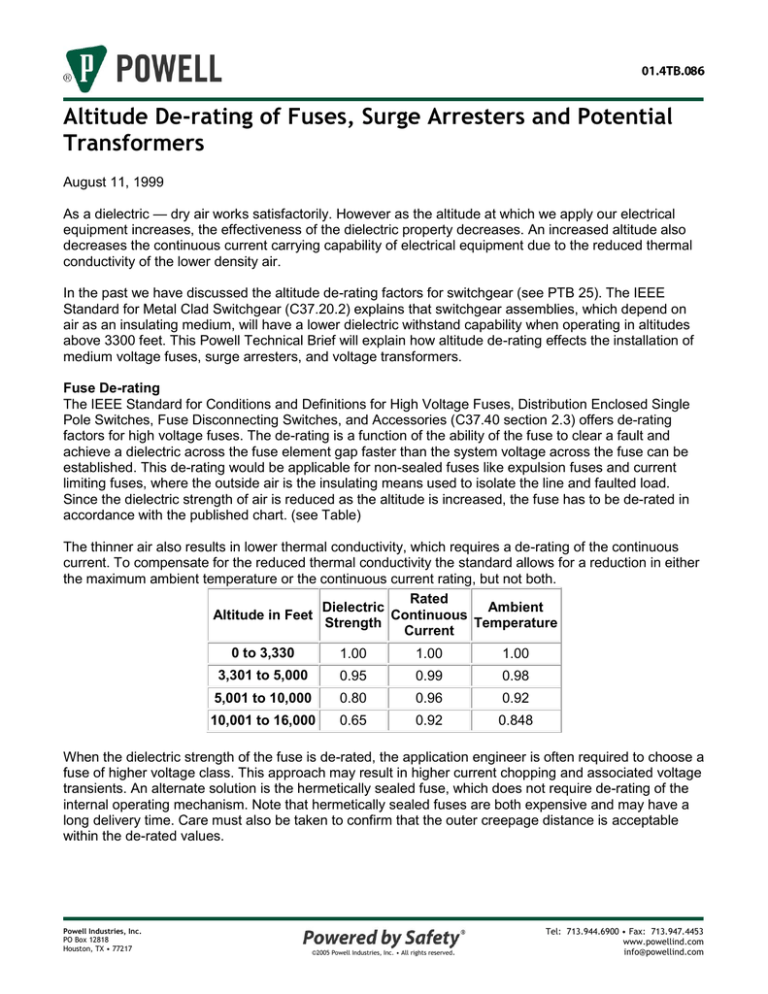
Altitude De-rating of Fuses, Surge Arresters and Potential
Transformers
August 11, 1999
As a dielectric — dry air works satisfactorily. However as the altitude at which we apply our electrical
equipment increases, the effectiveness of the dielectric property decreases. An increased altitude also
decreases the continuous current carrying capability of electrical equipment due to the reduced thermal
conductivity of the lower density air.
In the past we have discussed the altitude de-rating factors for switchgear (see PTB 25). The IEEE
Standard for Metal Clad Switchgear (C37.20.2) explains that switchgear assemblies, which depend on
air as an insulating medium, will have a lower dielectric withstand capability when operating in altitudes
above 3300 feet. This Powell Technical Brief will explain how altitude de-rating effects the installation of
medium voltage fuses, surge arresters, and voltage transformers.
Fuse De-rating
The IEEE Standard for Conditions and Definitions for High Voltage Fuses, Distribution Enclosed Single
Pole Switches, Fuse Disconnecting Switches, and Accessories (C37.40 section 2.3) offers de-rating
factors for high voltage fuses. The de-rating is a function of the ability of the fuse to clear a fault and
achieve a dielectric across the fuse element gap faster than the system voltage across the fuse can be
established. This de-rating would be applicable for non-sealed fuses like expulsion fuses and current
limiting fuses, where the outside air is the insulating means used to isolate the line and faulted load.
Since the dielectric strength of air is reduced as the altitude is increased, the fuse has to be de-rated in
accordance with the published chart. (see Table)
The thinner air also results in lower thermal conductivity, which requires a de-rating of the continuous
current. To compensate for the reduced thermal conductivity the standard allows for a reduction in either
the maximum ambient temperature or the continuous current rating, but not both.
Rated
Dielectric
Ambient
Altitude in Feet
Continuous
Strength
Temperature
Current
0 to 3,330
1.00
1.00
1.00
3,301 to 5,000
0.95
0.99
0.98
5,001 to 10,000
0.80
0.96
0.92
10,001 to 16,000
0.65
0.92
0.848
When the dielectric strength of the fuse is de-rated, the application engineer is often required to choose a
fuse of higher voltage class. This approach may result in higher current chopping and associated voltage
transients. An alternate solution is the hermetically sealed fuse, which does not require de-rating of the
internal operating mechanism. Note that hermetically sealed fuses are both expensive and may have a
long delivery time. Care must also be taken to confirm that the outer creepage distance is acceptable
within the de-rated values.
Powell Industries, Inc.
PO Box 12818
Houston, TX • 77217
©2005 Powell Industries, Inc. • All rights reserved.
Tel: 713.944.6900 • Fax: 713.947.4453
www.powellind.com
info@powellind.com
Altitude De-rating of Fuses, Surge Arresters and Potential
Transformers
page 2
Surge Arrester De-rating
There are two types of surge arresters in common use today -- the expulsion-type arrester and the metal
oxide arrester. The expulsion-type arresters have an internal system that depends on ambient air as a
dielectric and, as such, must be de-rated as a function of altitude just as fuses. The metal oxide surge
arresters are sealed and outside air does not play a part in the isolating process, so the surge arrester
does not require de-rating for the internals to operate properly. However, air also plays a part in the
external surface creepage distance of the housing. The outer surface has a certain creepage distance
that prevents the surge arrester housing from tracking across the surface of the arrester. Powell
Technical Brief # 59 describes the acceptable surface creepage distance for various impulse levels given
insulated conductors. The insulated conductor distances can only be used if an insulating boot properly
covers the ferrule at the top of the arrester.
Care must be exercised when applying the altitude de-rating factor. To maintain the desired discharge
level of the arrester and the required creep distance, it may be necessary to have special arresters
manufactured with a standard duty cycle arrester in a housing with higher creep levels.
A special caution when applying de-rated higher voltage current limiting fuses. Each fuse has a
characteristic current chop that results in a maximum allowable voltage transient of three times the rated
fuse voltage. The transients that result from applying a higher voltage class fuse due to altitude de-rating
can often result in the surge arrester conducting during a fuse interruption.
This should be avoided for line side station class and intermediate class arresters as the conducting
impedance of this arrester is low enough that conducting during a fault will cause serious damage.
Distribution class arresters have a high enough conducting impedance that this is not a problem.
Powell Industries, Inc.
PO Box 12818
Houston, TX • 77217
©2005 Powell Industries, Inc. • All rights reserved.
Tel: 713.944.6900 • Fax: 713.947.4453
www.powellind.com
info@powellind.com
Altitude De-rating of Fuses, Surge Arresters and Potential
Transformers
page 3
Voltage Transformer De-rating
When voltage transformers are applied at higher altitudes, ANSI C57.13, section 4.3, identifies the derating factors. This de-rating requires use of a higher voltage class transformer with the appropriate
primary voltage and the ratio to maintain the desired secondary voltage.
For example: Given a line-up of switchgear operating at 4.16kV at an altitude of 10,000 feet, the
appropriate choice is a voltage transformer with a primary voltage of 4200 Volts and a secondary of 120
Volts. The transformer would have an insulation class of 8.7kV with a BIL at sea level of 75kV. When the
80% de-rating factor is applied due to the altitude, this VT has a BIL of 60kV.
This Powell Technical Brief should clarify some of the concerns expressed by customers on recently
shipped substations installed at higher altitudes. If I can be of further assistance please do not hesitate to
call.
Jim Bowen
Technical Director
Powell Industries, Inc.
PO Box 12818
Houston, TX • 77217
©2005 Powell Industries, Inc. • All rights reserved.
Tel: 713.944.6900 • Fax: 713.947.4453
www.powellind.com
info@powellind.com


